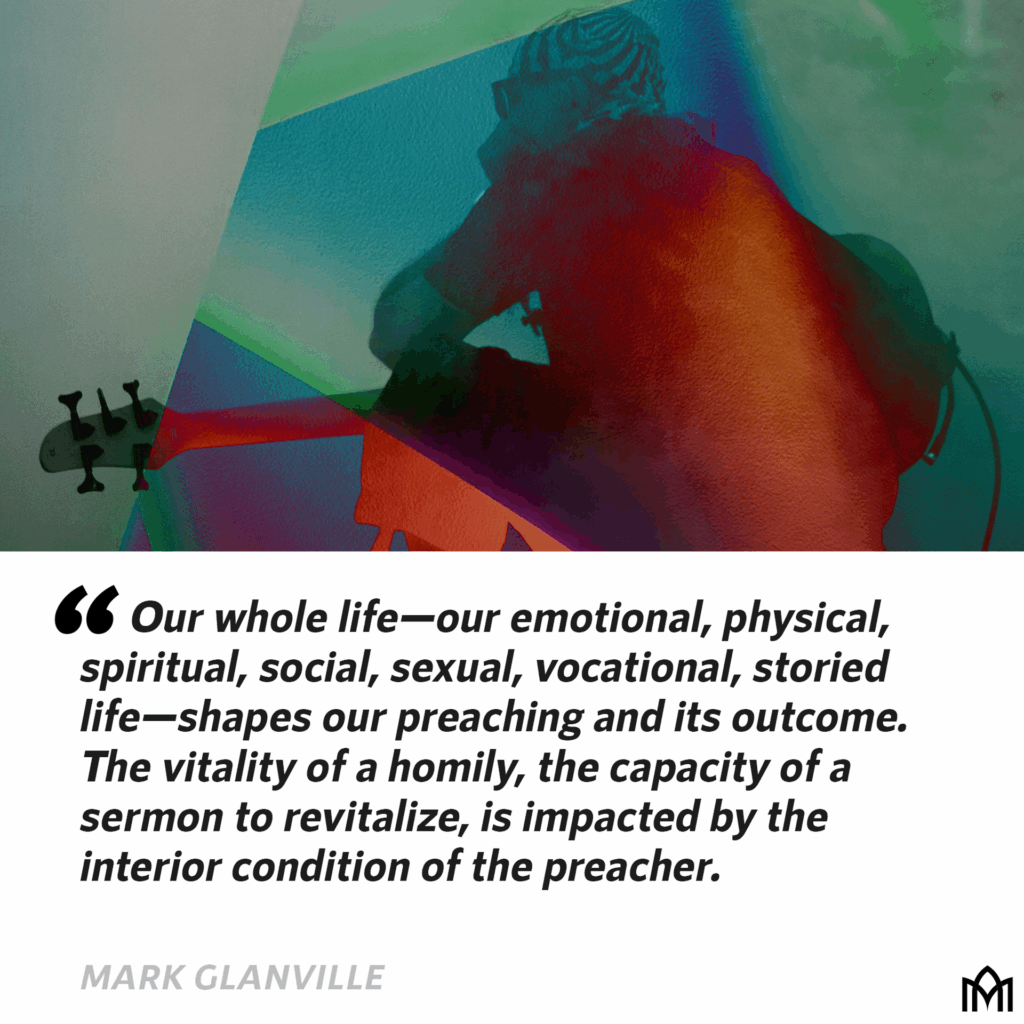Preaching in a New Key: A Preacher’s Holistic Health
Unrecognized Emotions are a Preacher’s Text
While I have long recognized the significance of a pastor’s inner life, I hadn’t pondered the relationship between our inner life and the act of preaching until recently. Our whole life—our emotional, physical, spiritual, social, sexual, vocational, storied life—shapes our preaching and its outcome. Sometimes, more than the content. It is commonplace, and important, to speak about a preacher’s prayer life. But that’s where the conversation usually stops. And yet spiritual and emotional health are inseparable. The vitality of a homily, the capacity of a sermon to revitalize, is impacted by the interior condition of the preacher.
I missed the importance of attending to our inner life for preaching until recently. I had a light bulb moment when I was teaching preaching to graduate students. A student, Samantha, was preaching on Ruth 2. Sam’s sermon was a high-quality narrative retelling of Ruth. It was gripping. Sam had worked with street-adjacent people in Sydney, Australia. She began her sermon by telling us how she had been sitting with a friend who was experiencing a drug overdose. Her friend’s heart stopped beating for a time, and she came close to death. As Sam told her important story in the sermon’s introduction, she had an edge in her voice, even a hint of anger. She ended the introduction by stating that we need to see the humanity in this woman. I noticed in myself that while I strongly shared Sam’s convictions, I wasn’t drawn into Sam’s experience.
Next, Sam dropped into the body of her sermon, a masterful retelling of the story of Ruth: an entrepreneurial outsider who becomes enfolded under Yahweh’s wings. Sam’s retelling was full of imagination and fascinating historical background. She made me feel like I was standing in the barley fields of ancient Bethlehem. I noticed that as Sam dropped into this narrative, her voice calmed, her face relaxed and even smiled, and her eyes sparkled with excitement.
When Sam finished, we discussed her sermon as a class. All agreed that the sermon was quite wonderful. Yet I was curious about the difference between Sam’s introduction, which left me disengaged, and her narrative, which captivated me. I had a hunch that whatever had happened in the introduction often happened in my own preaching, so I wanted to understand it.
As the whole class continued to converse, seeking to understand what had happened, I saw a connection I hadn’t noticed before. I offered to Sam that her introduction sounded as if it were delivered from her “defended self.” I was emotional as I spoke, for it was dawning on me that I preach, time and time again, from my defended self.
A foundation for healthy and effective preaching is our health in every domain of our lives–the spiritual, physical, emotional, sexual, social, and vocational. None of these domains can be ignored. They are all intertwined. Share on X
Betty Pries, an author and conflict consultant, uses the term “defended self” to describe “the self we develop to hide our vulnerability.”1Betty Pries, The Space Between Us: Conversations About Transforming Conflict (Harrisburg, VA: Herald, 2021), 83. Pries writes that our defended self is that part of us that emerges when our selfhood is threatened.2Pries, The Space Between Us, 83-89. Our defended self lies behind our negative self-talk: “Now I’ve proved that I am a poor leader.” And it is the source of self-congratulatory assumptions, like: “I’m the only one holding this place together.” We often preach from our defended self when we have unresolved anger at the congregation. In difficult pastoral circumstances, a cycle of conflict and preaching from our defended self can continue for years and years. My defended self shows up, to a greater or lesser degree, in every sermon I preach. Often I’m not even aware of it.
But Sam didn’t stay in her defended self. As she dropped into the narrative of Ruth 2 as a skillful storyteller, her face relaxed. Sam put the beauty of this story on full display as she ingeniously interwove narrative movement with historical details of daily life. I could feel that she loved this story, and she loved us. Now Sam was at her best. Buoyed by the beauty of the story and the joy of using her aesthetic gifts, she had shifted from her defended self into her “deeper self.”
Pries describes our deeper self as, “the most intimate layer of our selfhood…sometimes simply known as the place of one’s heart.”3Pries, The Space Between Us, 89. Our deeper self is anchored in God and in who God has created us to be. And our deeper self is integrated, in heart, mind, body, and community. We know when we are living out of our deeper self (rather than our defended self) when our face is relaxed, we are open to connection to others and to God, and we are feeling flexible and creative.
As Sam retold the narrative of Ruth 2, her face relaxed. And as Sam’s face relaxed, our faces as listeners relaxed. When we are preaching, it is not always the emotion that we consciously project that the congregation takes on; it may be an unexamined emotion. Sam’s emotional journey in her sermon was probably unintentional. The pathway to preaching from our deeper self as often as possible is our holistic health.
A call for preachers to pursue holistic health is not a call to adopt a psychological model but a call to faithfulness, a call to Jesus. After all, we desire to hear God’s address in Scripture, do we not? And yet if we don’t do this inner work, our unrecognized wounds may not only influence how we preach, but even how we read Scripture. If our goal is to read Scripture clearly, to respect others, to nurture healthy churches, and to demonstrate humble honesty about what we bring to the preaching task, we need to do this inner work.
The pathway to preaching from our deeper self as often as possible is our holistic health. A call for preachers to pursue holistic health is not a call to adopt a psychological model but a call to faithfulness, a call to Jesus. Share on X
How can we preach from a place of health, from our deeper self?
- One strategy is to learn to recognize the signs of health and illness in our preaching. Learning to recognize these signs is a life-long journey of growing in self-knowledge. If you want to gauge the health of your preaching, at a basic level, ask yourself: “Am I preaching out of frustration with my congregation, today?” A contemplative pastor may be frustrated by a lack of prayer. A tired pastor may be frustrated at lack of engagement. Whatever it is that frustrates you will inevitably leak into your preaching—you are only human. So, be alert to when you are preaching out of frustration.
- Another sign: Do you love your people as you stand and preach to them? This, too, gauges your inner condition. A subtle lens, one requiring discernment, is recognizing the shape of your desire for your congregation to be transformed. Can we offer an invitation genuinely and humbly, trusting in God’s timing for our community?
A foundation for healthy and effective preaching is our health in every domain of our lives, including the spiritual, physical, emotional, sexual, social, and vocational. None of these domains can be ignored, for they are all intertwined and interdependent.
What Needs to Shift Within?
Having read this short reflection, you might consider pausing to journal, taking stock of your life in the various domains of your interior life as a preacher. What needs to shift within you as you sit with God?
///
This is an adapted excerpt from Preaching in a New Key: Crafting Expository Sermons in Post-Christian Neighborhoods (IVP Academic, 2025). © 2025 by Mark Richard Glanville. Used by permission of InterVarsity Press.
A subtle lens, one requiring discernment, is recognizing the shape of your desire for your congregation to be transformed. Can we offer an invitation genuinely and humbly, trusting in God’s timing for our community? Share on X




